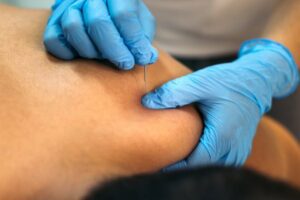Dry Needling
Article by John Miller

Dry Needling
An Effective Physiotherapy Technique
Introduction
As practicing physiotherapists, we regularly witness the transformative effects of dry needling on patients grappling with various musculoskeletal issues. This technique, which involves the precise insertion of a fine needle into specific muscle tissues, has gained considerable attention for its effectiveness in alleviating pain and enhancing mobility.
Understanding Dry Needling
Dry Needling targets myofascial trigger points, commonly referred to as muscle knots. These points are often the epicentres of muscle pain and can limit movement. Unlike acupuncture, dry needling is based on modern Western medical principles, focusing on anatomical and neurophysiological theories.

The Science Behind Myofascial Trigger Points
Myofascial trigger points develop from prolonged muscle contraction, leading to tightness, tension, and pain. These can arise from various causes, including injury, stress, or even nutritional deficiencies.
How Dry Needling Works
In dry needling, inserting a needle into a trigger point can trigger a reflex that relaxes the muscle. This process not only alleviates pain but also improves blood circulation, providing essential nutrients and oxygen to the affected area.
When to Consider Dry Needling
We may recommend dry needling for a range of conditions, such as chronic pain, muscle injuries, sports injuries, and conditions like fibromyalgia. However, it’s crucial to seek treatment from a trained professional due to the invasive nature of the therapy.
Patient Experiences During Treatment
Patients may experience a spectrum of sensations, from a slight prick to a muscle twitch, indicating an effective response. While side effects like soreness or bruising are common, they typically resolve quickly.
Dry Needling in Rehabilitation
Dry needling is an invaluable component of rehabilitation programs. It works effectively both as a standalone treatment and in conjunction with other physiotherapy techniques. Its key roles include managing pain, improving joint mobility, and releasing myofascial trigger points.
Recent Dry Needling Research
Recent research, such as the 2023 study by Chys et al., demonstrates the effectiveness of dry needling in reducing pain across various body regions in the short term. It is more effective than no treatment or placebo in improving pain intensity (Chys et al., 2023).
Safety and Post-Treatment Care
Dry needling is generally safe, but like any treatment, it can have side effects. Patients are advised to avoid strenuous activities immediately after treatment to maximise the benefits. Most symptoms dissipate within 24 to 48 hours.
Conditions Benefited by Dry Needling
Dry needling can be effective for a range of conditions, including:
A thorough assessment by a healthcare professional is essential to determine its suitability.
In Conclusion
Dry needling is a scientifically-backed technique that offers significant benefits in managing musculoskeletal pain and dysfunction. As a qualified physiotherapist, I strongly advocate its use as part of a comprehensive treatment plan.
What to Do Next?
If you’re experiencing pain or limited mobility, consulting a physiotherapist trained in dry needling can be a beneficial step. At PhysioWorks, our team of qualified professionals can provide a customised treatment plan to meet your unique needs and goals. Remember, individual responses to treatment vary, and a personalised approach is crucial for effective rehabilitation.
For more information and to understand how dry needling can benefit you, visit PhysioWorks. Here, you’ll find a wealth of resources and can book an appointment with one of our skilled physiotherapists who is trained in dry needling.
Rochedale - Call 38410277
Book Online: RochedaleSalisbury - Call 32751044
Book Online: SalisburySandgate - Call 32691122
Book Online: SandgateDry Needling FAQs
1. What is dry needling and how does it work? Dry needling involves inserting fine needles into muscle trigger points to relieve pain and improve mobility by relaxing the muscle and enhancing blood flow.
2. What conditions can be treated with dry needling? Dry needling can treat conditions such as back pain, neck pain, shoulder pain, knee pain, sciatica, headaches, elbow pain, and muscle injuries.
3. How does dry needling differ from acupuncture? While both involve needle insertion, dry needling is based on Western medical principles and targets myofascial trigger points, whereas acupuncture is rooted in traditional Chinese medicine.
4. What should I expect during a dry needling session? You may feel sensations ranging from a slight prick to a muscle twitch. Some soreness or bruising can occur but usually resolves quickly.
5. Is dry needling safe? Dry needling is generally safe when performed by a trained professional. Side effects are usually minor and temporary, such as soreness or bruising.
6. How soon will I see results from dry needling? Many patients experience relief after a few sessions, but results can vary depending on the condition and individual response to treatment.
Related Articles
- Trigger Point Therapy
- Learn how trigger point therapy can alleviate muscle pain.
- Physiotherapy for Back Pain
- Discover effective treatments for managing back pain.
- Neck Pain Management
- Explore strategies to relieve neck pain and improve function.
- Shoulder Pain Treatment
- Find out how to treat shoulder pain with physiotherapy.
- Knee Pain Solutions
- Learn about various treatments for knee pain.
- Sciatica Relief
- Understand how physiotherapy can help alleviate sciatica symptoms.
- Headache and Migraine Treatment
- Discover techniques to manage headaches and migraines.
- Elbow Pain Management
- Explore treatments for different types of elbow pain.
- Sports Injury Rehabilitation
- Learn about rehabilitation techniques for sports injuries.
- Fibromyalgia Treatment
- Find out how physiotherapy can help manage fibromyalgia symptoms.
These links offer a range of information and treatments related to dry needling and musculoskeletal health.
Social Media Follow Us for Free Tips
Stay informed about dry needling and other treatment options by following us on social media! Get regular tips on dry needling, self-management, stretching techniques, and more to keep your muscles healthy.















































